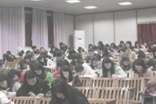- 相关推荐
2017年托福考试全真试题练习
除了课堂上的学习外,平时的积累与练习也是学生提高成绩的重要途径,以下是小编为大家搜索整理的2017托福考试全真试题练习,希望能给大家带来帮助!更多精彩内容请及时关注我们应届毕业生考试网!

reading comprehension
time: 55 minutes (including the reading of the directions). now set your clock for 55 minutes.question 1——10
the word laser was coined as an acronym for light amplification by the stimulated
emission of radiation. ordinary light, from the sun or a light bulb, is emitted
spontaneously, when atoms or molecules get rid of excess energy by themselves, without
any outside intervention . stimulated emission is different because it occurs when an
atom or molecule holding onto excess energy has been stimulated to emit it as light.
albert einstein was the first to suggest the existence of stimulated emission in a
paper published in 1917. however , for many years physicists thought that atoms and
molecules always were much more likely to emit light spontaneously and that stimulated
emission thus always would be much weaker. it was not until after the second world
war that physicists began trying to make stimulated emission dominate. they sought
ways by which one atom or molecule could stimulate many other to emit light ,
amplifying it to much higher powers.
the first to succeed was charles h.townes, then at colombia university in new
york . instead of working with light , however, he worked with microwaves, which have
a much longer wavelength, and built a device he called a "maser" for microwave
amplification by the stimulated emission of radiation. although he thought of the
key idea in 1951, the first maser was not completed until a couple of years later. before
long, many other physicists were building masers and trying to discover how to produce
stimulated emission at even shorter wavelength.
the key concepts emerged about 1957. townes and arthur schawlow, then at bell
telephone laboratories, wrote a long paper outlining the conditions needed to amplify
stimulated emission of visible light waves. at about the same time, similar ideas
crystallized in the mind of gordon gould, then a 37- year-old graduate student at
columbia, who wrote them down in a series of notebooks. townes and schawlow
published their ideas in a scientific journal, physical review letter, but gould filed a
patent application. three decades later, people still argue about who deserves the credit
for the concept of the laser.
1. the word "coin" in line 1 could be replaced by
(a) created
(b) mentioned
(c) understood
(d) discovered
2. the word "intervention" in line 4 can best be replaced by
(a) need
(b) device
(c) influence
(d) source
3. the word "it" in line 5 refers to
(a) light bulb
(b) energy
(c) molecule
(d) atom
4. which of the following statements best describes a laser?
(a) a device for stimulating atoms and molecules to emit light
(b) an atom in a high-energy state
(c) a technique for destroying atoms or molecules
(d) an instrument for measuring light waves
5. why was towne’s early work with stimulated emission done with microwaves?
(a) he was not concerned with light amplification
(b) it was easier to work with longer wavelengths.
(c) his partner schawlow had already begun work on the laser.
(d) the laser had already been developed
【托福考试全真试题练习】相关文章:
托福考试全真测试题07-14
2017年托福考试全真试题测试09-20
专八英语改错试题全真模拟练习11-08
托福考试听力试题模拟练习09-03
托福考试练习试题2017年05-18
2017年pets5全真模拟试题练习08-04
2017年托福考试练习巩固试题08-28
2017普通话水平测试全真模拟练习试题06-30